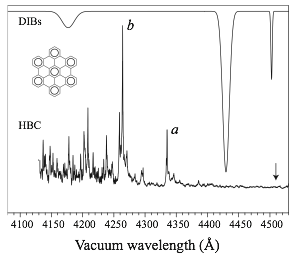
Back to Table of Contents
46574-UFS
Electronic Spectroscopy of Polycyclic Aromatic Hydrocarbons (PAHs) in the Gas Phase
Thomas D. Varberg, Macalester College
I
spent the period August 24, 2007 to August 14, 2008 as a Visiting Professor of
Chemistry at the University of Sydney, Australia, funded by my ACS-PRF UFS
grant. My sabbatical hosts were Prof. Scott Kable and Dr. Tim Schmidt in the
School of Chemistry.The
goal of our collaborative work, as described in my original proposal, was to
measure electronic spectra of new, large polycyclic aromatic hydrocarbons
(PAHs), which are proposed to exist in the interstellar medium and are
potential candidates as carriers of the still unidentified "diffuse
interstellar bands" first described in the 1920s. We used two-color
resonance-enhanced multiphoton ionization (REMPI) spectroscopy as our preferred
technique to make these measurements.
 Our initial experiment upon my arrival in
Sydney was to carry out REMPI measurements on the carrier of a strong
electronic transition at 476.02 nm. I worked alongside of graduate student
Damian Kokkin in this project. The carrier of this spectrum was not identified
at the time of my writing the PRF proposal. In the intervening time, it has
been identified to be the phenyl propargyl radical. The electronic spectrum of
this radical was first measured in the Kable/Schmidt lab (by graduate student
Neil Reilly) by recording its laser-induced fluorescence spectrum. Our contribution
was to measure its REMPI spectrum, which will be included in a forthcoming
publication describing the electronic structure of the molecule.
Our initial experiment upon my arrival in
Sydney was to carry out REMPI measurements on the carrier of a strong
electronic transition at 476.02 nm. I worked alongside of graduate student
Damian Kokkin in this project. The carrier of this spectrum was not identified
at the time of my writing the PRF proposal. In the intervening time, it has
been identified to be the phenyl propargyl radical. The electronic spectrum of
this radical was first measured in the Kable/Schmidt lab (by graduate student
Neil Reilly) by recording its laser-induced fluorescence spectrum. Our contribution
was to measure its REMPI spectrum, which will be included in a forthcoming
publication describing the electronic structure of the molecule.
 Following this initial experiment, we sought
to measure REMPI spectra of several different organic free radicals that have
not been measured in the gas phase. An example of these is the indenyl radical.
We attempted to produce this free radical in the gas phase by expanding indenyl
iodide in a molecular beam, which was passed through a pulsed electric
discharge just downstream from the pulsed nozzle. We searched for the electronic
spectrum of this radical, guided by a previous low-resolution spectrum in a
solid matrix, but were unable to observe it.
Following this initial experiment, we sought
to measure REMPI spectra of several different organic free radicals that have
not been measured in the gas phase. An example of these is the indenyl radical.
We attempted to produce this free radical in the gas phase by expanding indenyl
iodide in a molecular beam, which was passed through a pulsed electric
discharge just downstream from the pulsed nozzle. We searched for the electronic
spectrum of this radical, guided by a previous low-resolution spectrum in a
solid matrix, but were unable to observe it.
 Together with graduate
student Tyler Troy, Kokkin and I
then began an ultimately successful search for the electronic spectrum of the
large polycyclic aromatic hydrocarbon, hexa-peri-hexabenzocoronene (HBC),
C42H18. This compound was synthesized in collaboration
with Dr. Nigel Lucas of the School of Chemistry. The targeted species was
seeded in argon by ablating the solid HBC sample with laser pulses produced by
a doubled (532 nm) Nd:YAG laser. Jet-cooled HBC molecules were cooperatively
ionized by two laser pulses: the first was tuned to place HBC molecules into an
excited state from where they could be ionized by the second, ̃xed wavelength pulse.
Together with graduate
student Tyler Troy, Kokkin and I
then began an ultimately successful search for the electronic spectrum of the
large polycyclic aromatic hydrocarbon, hexa-peri-hexabenzocoronene (HBC),
C42H18. This compound was synthesized in collaboration
with Dr. Nigel Lucas of the School of Chemistry. The targeted species was
seeded in argon by ablating the solid HBC sample with laser pulses produced by
a doubled (532 nm) Nd:YAG laser. Jet-cooled HBC molecules were cooperatively
ionized by two laser pulses: the first was tuned to place HBC molecules into an
excited state from where they could be ionized by the second, ̃xed wavelength pulse.The
resonant 2-color 2-photon ionization spectrum of HBC is shown in Fig. 1. The
spectrum is for the 522-amu (12C421H18)
mass only, and as such it represents only the most abundant isotopomer (64%).
The main features are positioned at 433.52 and 426.41 nm, labeled 'a' and 'b' in Fig. 1. We attribute the cluster of smaller peaks immediately
to longer wavelength of these main features to "hot" bands, which are transitions
arising from excited vibrational levels of the electronic ground state that
remain populated by incomplete cooling in the supersonic expansion. To higher
energy than these main features lie transitions involving quanta of totally
symmetric vibrations built onto bands a
and b.

Fig. 1: The excitation
spectrum of hexa-peri-hexabenzocoronene (bottom) and a reconstruction of the
diffuse interstellar band spectrum (top) from Jenniskens and Desert [1]. The
arrow denotes an estimate of the position of the forbidden origin band, based
on the solution phase spectra of Hendel, Khan and Schmidt [2].This
spectrum represents the ̃rst optical spectrum of an isolated polycyclic
aromatic hydrocarbon large enough to survive the photophysical conditions of
the interstellar medium to be reported. This study opens up the possibility to
rigorously test neutral polycyclic aromatic hydrocarbons as carriers of the
diffuse interstellar bands in the near future.Towards
the end of my time in Australia, I worked with Tyler Troy in searching for the
REMPI gas-phase spectra of the two molecules shown below, one a simple
gold-dithiol and the other a larger PAH derived from HBC. While we were initially
unsuccessful, spectroscopic work on these two molecules is continuing.


Finally,
we spent a few weeks fitting our recorded spectra of several vibrational bands
of the A1P–X1S+, C1P
–X1S+ and D1S+–X1S+ systems of the molecule gold fluoride (AuF). These electronic
spectra were recorded in the summer of 2007 at Macalester College, and the
analysis was undertaken with support from this PRF grant at the University of
Sydney. We have completed our fitting of these bands, including a full analysis
of the hyperfine structure of the
C–X system and are presently preparing a manuscript for publication.[1]
Jenniskens, P.; Desert, F. X. Astron. Astrophys. Supp. Ser. 1994,106, 39.[2] Hendel, W.; Khan, Z. H.; Schmidt W. Tetrahedron 1986, 42, 1127.
Back to top







